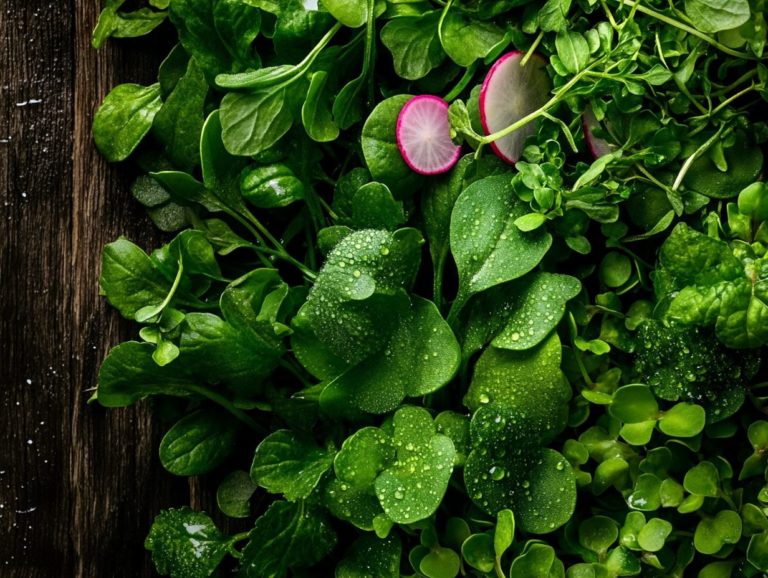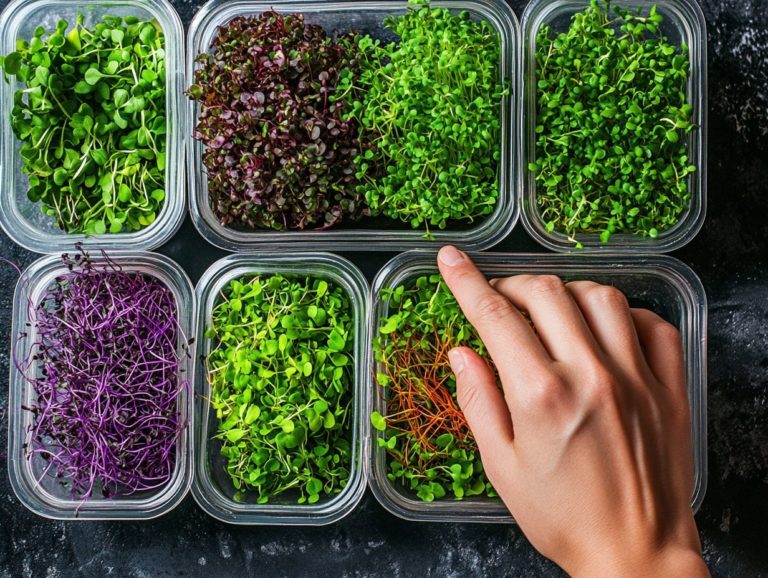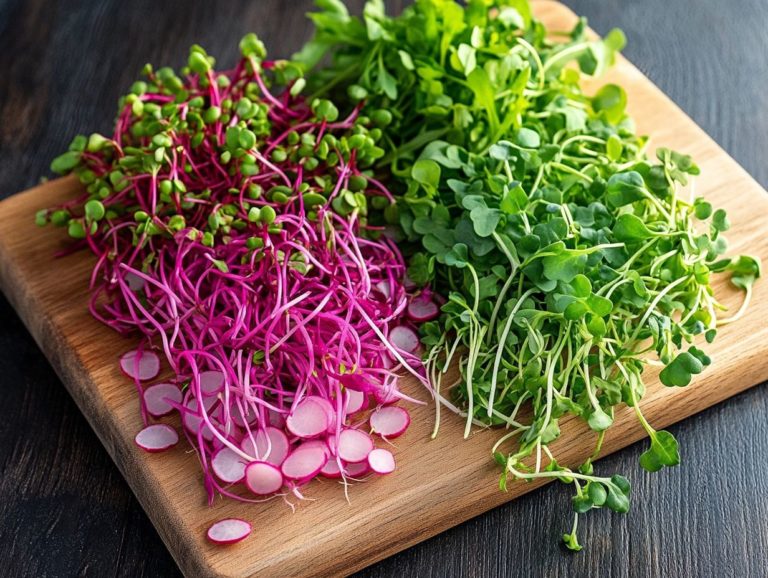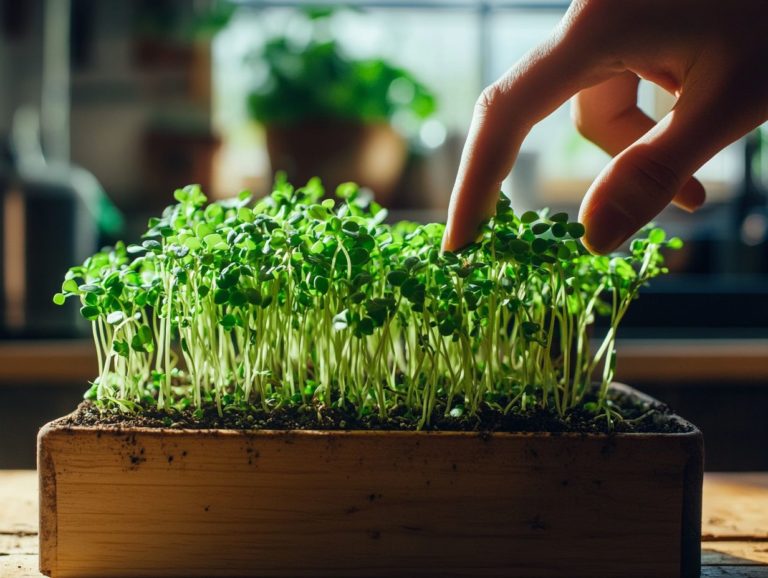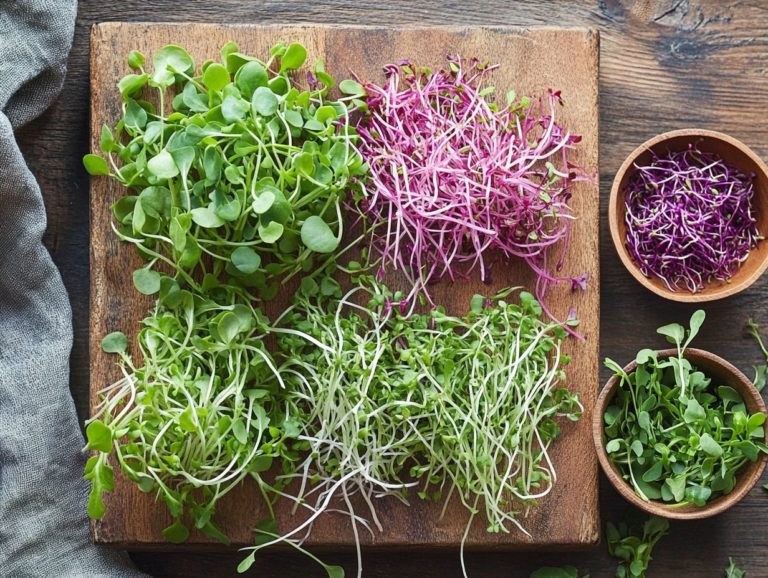The Health Benefits of Microgreens for Seniors
Microgreens those tiny, nutrient-packed seedlings are far more than just fashionable garnishes. They represent a significant enhancement to your diet, especially for seniors, providing a powerful nutritional boost that can help combat chronic diseases.
Rich in vitamins, minerals, and antioxidants, these miniature greens offer a wealth of health benefits. They provide dietary fiber and concentrated nutrients that can effectively address common age-related concerns.
This exploration will delve into what microgreens are, their remarkable nutritional profile, and how they can elevate your meals with a rich array of phytonutrients.
You ll discover practical tips for incorporating them seamlessly into your diet, including raw vegetables, as well as a straightforward guide to growing microgreens at home. Learn how microgreens can enrich your well-being and vitality during your later years.
We will also discuss important safety tips to ensure you enjoy a healthy experience while appreciating the benefits of these young vegetables.
Get ready to embrace the green revolution with delicious microgreens!
Contents
- Key Takeaways:
- What are Microgreens?
- Nutritional Value of Microgreens
- How Microgreens Benefit Seniors
- How to Incorporate Microgreens into Senior Meals
- Growing Microgreens at Home
- Safety Considerations for Seniors
- Frequently Asked Questions
- What are microgreens?
- What are the health benefits of microgreens for seniors?
- How can microgreens benefit senior immune systems?
- Do microgreens have any anti-inflammatory properties?
- Are there any specific types of microgreens that are especially beneficial for seniors?
- How can seniors incorporate microgreens into their diets?
Key Takeaways:

- Microgreens are young, nutrient-rich plants that can be easily added to senior meals. They provide essential vitamins, minerals, and health benefits to help seniors combat common health issues like inflammation and cognitive decline.
- Including a variety of microgreens in a senior’s diet can offer a range of benefits, such as improved digestion, boosted immunity, and a reduced risk of chronic diseases. Greens like broccoli and spinach are great additions to any senior’s meal plan.
- Growing microgreens at home is a simple and affordable way for seniors to have a fresh supply of nutritious greens. However, seniors should take precautions and be aware of potential risks, such as foodborne illnesses, when consuming these essential, health-promoting ingredients.
What are Microgreens?
Microgreens are young, edible plants harvested just after the first true leaves appear. They offer a remarkable nutritional boost packed with concentrated nutrients like a compound found in some vegetables that may help fight cancer.
Often derived from a variety of seeds, particularly from the Brassicaceae family (which includes veggies like broccoli and cabbage), these vibrant greens are not only a feast for the eyes but also a nutrient-rich enhancement for your meals.
With their versatility, you can easily incorporate microgreens into salads, sandwiches, and smoothies, making them a vital addition to your diet if you’re looking to elevate your culinary experience and support heart health. Additionally, understanding the influence of microgreens on overall nutrition can enhance their benefits in your meals.
Definition and Types
Microgreens are essentially the young seedlings of vegetables and herbs, harvested at an early stage when they stand just 1 to 3 inches tall. You ll find a delightful variety among them, including crowd favorites like broccoli, spinach, fenugreek, and red cabbage, all packed with antioxidants.
These petite greens do more than just add color to your dishes; they bring a spectrum of flavors, from the peppery zing of arugula to the sweet nuances of basil. Nutritionally, microgreens are a powerhouse of concentrated nutrients. For example, broccoli microgreens are abundant in sulforaphane and polyphenols, compounds known for their potential cancer-fighting properties and overall health benefits, as highlighted in the impact of microgreens on overall wellbeing.
The growing process is refreshingly simple, requiring minimal space and resources, making them a perfect choice for home gardeners. In the culinary world, they can elevate salads, sandwiches, and even gourmet creations, enhancing both texture and visual appeal while providing a nutritional punch.
Nutritional Value of Microgreens
The nutritional value of microgreens is impressive, offering a boost that outshines some of their fully grown counterparts, especially due to their rich content of B vitamins and iron. These petite greens are bursting with vitamins, minerals, and antioxidants, making them a concentrated source of essential nutrients for your well-being.
Rich in dietary fiber and natural compounds found in plants that are beneficial for health, microgreens elevate your meals and deliver a range of health benefits. To understand why these tiny greens are so powerful, check out why microgreens are superfoods you need. These include the promotion of heart health and potential cancer prevention, particularly relevant for individuals at risk for heart disease.
Key Nutrients and Health Benefits
Microgreens are a treasure trove of key nutrients that offer various health benefits. Their impressive antioxidant properties are associated with cancer prevention and better blood sugar management, supporting those facing Type 2 diabetes.
These tiny greens are brimming with essential vitamins, minerals, and natural compounds found in plants that are beneficial for health. Varieties like broccoli and kale microgreens are particularly high in sulforaphane, a compound studied for its potential to reduce cancer risk by detoxifying carcinogens. Additionally, beet microgreens shine with their high betalains content, known for anti-inflammatory benefits, along with nutrient-rich elements like lutein. To discover more about their health benefits, check out unlocking the antioxidant power of microgreens.
Research published in the Journal of Food Science shows that the antioxidants in microgreens can combat oxidative stress, a factor in chronic diseases like diabetes and heart disease. By adding these nutrient-dense plants to your diet, you can enhance your ability to manage insulin resistance, promoting better overall metabolic health. For more information on their benefits, read about why microgreens are essential for a balanced diet.
How Microgreens Benefit Seniors

Microgreens deliver health benefits for seniors, providing a nutritional boost that combats prevalent health concerns like heart disease, cancer, and malnutrition. They are an excellent choice for everyday wellness.
They also support cognitive health and may lower the risk of Alzheimer s disease. This makes them a smart option for maintaining overall well-being, especially with their rich array of antioxidants.
Addressing Common Health Issues
Seniors face health challenges like cancer, heart disease, and malnutrition. Incorporating nutrient-rich microgreens into their diets can significantly help address these issues.
These powerhouses are loaded with essential vitamins, minerals, and antioxidants that support overall well-being. For instance, microgreens like broccoli and kale contain sulforaphane, known for its cancer-fighting properties, beneficial for older adults at higher risk for chronic diseases. Additionally, understanding the role of microgreens in healthy eating can enhance your diet. Varieties like pea shoots and radish greens are abundant in vitamin C, crucial for boosting the immune system and promoting heart health.
By choosing microgreens, seniors can enhance their nutrient intake, helping build resilience against chronic diseases while fighting malnutrition. Exploring the top microgreen varieties for health enthusiasts can be a great way to incorporate these nutrient-dense foods into their diet. Even small dietary shifts can lead to substantial health benefits for this age group.
How to Incorporate Microgreens into Senior Meals
Incorporating microgreens into meals is a creative and effortless endeavor. They offer a versatile addition that boosts nutritional value and promotes overall health, especially with their low fat and high nutrient content.
Creative and Easy Ways to Add Microgreens to Meals
There are countless creative and effortless ways for you to incorporate microgreens into your meals. You might toss a handful into salads or smoothies. You can also use them as colorful toppings on your favorite sandwiches, enhancing the flavor profile with powerful nutritional elements.
These amazing little greens do so much more than just enhance the visual appeal of your dishes; they also pack a flavorful and nutrient-rich punch, offering a concentrated source of antioxidants. Imagine mixing them into omelets for extra texture or blending them into pesto for a unique twist. The possibilities are truly endless!
Consider pairing peppery arugula microgreens with creamy avocado on toast for a delightful breakfast. You can also mix sweet sunflower microgreens into fruit salads for an enticing contrast. By experimenting with different flavors and textures, such as those from raw vegetables, you can uncover the hidden health benefits of microgreens and their remarkable versatility in your cooking.
Growing Microgreens at Home
Growing microgreens at home offers a rewarding and simple experience. You can savor fresh, nutrient-dense greens while enjoying a multitude of health benefits.
Step-by-Step Guide to Growing Microgreens

To successfully grow microgreens at home, follow this step-by-step guide:
- Select the right seeds, such as amaranth and fenugreek.
- Use quality soil.
- Ensure adequate light.
- Maintain proper watering practices.
This journey begins with choosing seeds that match your personal taste and desired nutrient levels. Mustard and peas are great options, as various microgreens offer unique flavors and health benefits.
Once that s sorted, preparing a suitable growing medium is essential. Opting for organic potting mix or specialized microgreen soil can significantly enhance germination rates.
Don t underestimate the importance of adequate light exposure. Whether it s from natural sunlight or grow lights, this is critical for promoting healthy growth. Regarding watering, remember to do so lightly to prevent waterlogging; microgreens thrive in a consistently moist, but not soggy, environment.
Lastly, patience is your ally. These greens typically reach harvestable size within 7 to 21 days, depending on the variety, including quick-growing options like Swiss chard. Start growing your own microgreens today for a truly rewarding home gardening experience!
Safety Considerations for Seniors
While microgreens present a wealth of health benefits, such as supporting heart health, it s crucial to take safety precautions into account. Be aware of potential risks related to their consumption.
Pay particular attention to soil quality and food safety practices to ensure a wholesome experience.
Precautions and Risks to be Aware of
Seniors need to be mindful of specific precautions and risks when indulging in microgreens. This is particularly important concerning potential food safety issues related to soil contamination and improper handling.
To ensure a safe and delightful experience, it’s essential for older adults to source microgreens from reputable suppliers. Look for those who emphasize high-quality products and adhere to stringent food safety standards. When choosing these delicate greens, seeking out organic certifications can further minimize exposure to harmful chemicals. Additionally, understanding the science behind microgreens and health is beneficial for making informed choices.
Thoroughly washing microgreens under running water is a vital step to eliminate any potential pathogens. Equally important is the avoidance of cross-contamination; using clean cutting boards and utensils is a must. Consuming the greens promptly after purchase maintains their freshness and significantly reduces the risk of spoilage. Additionally, you can explore the nutritional advantages of microgreens for kids to understand their benefits better.
Frequently Asked Questions
What are microgreens?
Microgreens are tiny greens, harvested after they have just sprouted and developed their first set of true leaves. They are typically smaller than baby greens but larger than sprouts, and they are packed with nutrients and flavor.
What are the health benefits of microgreens for seniors?
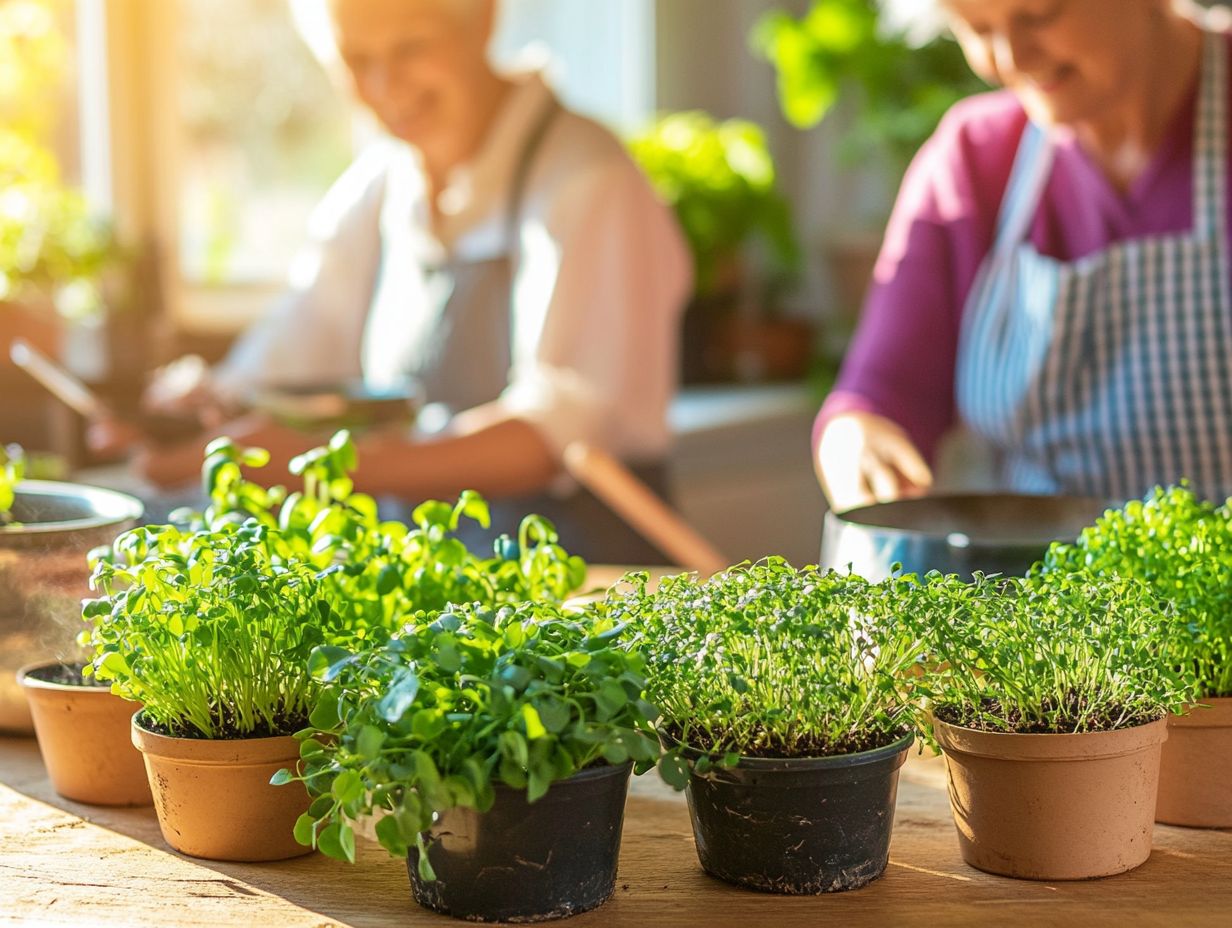
Microgreens are packed with vitamins, minerals, and antioxidants. They are a fantastic addition to a senior’s diet.
How can microgreens benefit senior immune systems?
Microgreens are rich in vitamins A, C, and E. These vitamins help seniors fight off infections and protect against chronic illnesses.
Do microgreens have any anti-inflammatory properties?
Yes, microgreens have anti-inflammatory properties. This is beneficial for seniors who may experience joint pain or other age-related issues.
Are there any specific types of microgreens that are especially beneficial for seniors?
While all microgreens offer health benefits, some are particularly good for seniors. For instance, broccoli microgreens contain a natural compound linked to reducing the risk of chronic diseases.
How can seniors incorporate microgreens into their diets?
Microgreens can easily enhance various dishes, like salads, sandwiches, and smoothies. They also make great garnishes for soups and omelets.
Plus, seniors can grow their own microgreens at home! It’s a fun, fresh, and budget-friendly way to boost nutrition.


